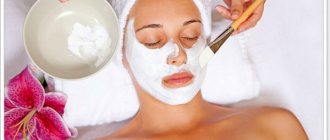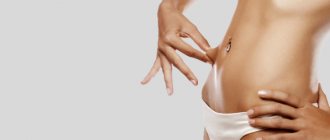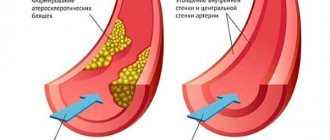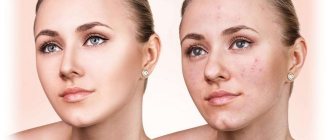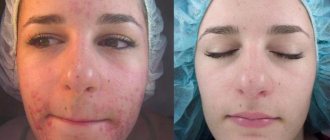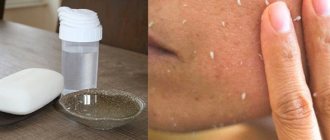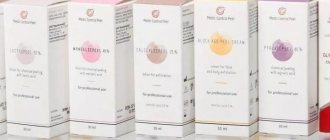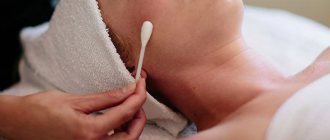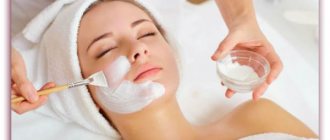Peeling with the addition of lactic acid is recognized as the most gentle and safe, since the product is used even on very sensitive skin. In general, milk peeling is called superficial - with the exception of specific aggressive agents produced by some manufacturers (which have a high percentage of concentration and low pH). In other words, the result from some products can be equated to a superficial-medium or medium peeling. However, in this article we will consider a superficial procedure that affects the stratum corneum of the epidermis.
Milk peeling
The event we are considering is recommended mainly for those with young skin with minor defects or for women over 35 years old (then this peeling is included in a set of other measures), since it affects the upper layers of the epidermis. Clients leave mostly positive reviews about milk peeling. An additional effect is good skin hydration.
A little about lactic acid
Lactic is a group of naturally occurring acids. Its formation occurs during the breakdown of glucose. Since the said acid is natural, it is safe for the human body, because it takes part in carbohydrate metabolism, being an important component of the natural moisturizing factor of the skin.
Lactic acid does not harm the body
Large-scale production of the named substance involves the use of an enzymatic reaction - lactic acid fermentation of glucose must occur. Under natural conditions, this acid is easily found in spoiled dairy products, pickled or pickled vegetables, mature cheese, and is also formed during the fermentation of wine or beer. The molecule of this substance is small in size, as a result of which it penetrates through the cell membrane without problems. Thanks to this, lactic acid evenly affects the treated area of the skin and acts equally.
As already mentioned, the milk peeling procedure is gentle and does not injure the skin. It is perfect for very sensitive skin, dry or problematic oily skin.
Important ! In other words, the use of such acid in peeling is suitable for absolutely any skin type.
This acid is suitable for any skin type
The active component stimulates the regeneration processes of epidermal cells, has a positive effect on microscopic circulation, and accelerates the production of lycosaminoglycans and collagen in the skin. Milk peeling also enriches the skin with essential moisture and improves the protection of the fat barrier.
Milk peeling improves the main processes in the facial skin
How does lactate affect the skin?
Under the influence of an acidic environment, the stratum corneum softens and becomes thinner, making the skin softer and more tender. Penetrating into the thickness of the sebaceous glands, lactate succeeds in liberating the ducts from plugs that are formed due to the accumulation of dirt, decorative cosmetics, excess sebum and exfoliated epithelium. Result: elimination of blackheads and prevention of inflammatory processes. The latter becomes possible thanks to lactions, which have an antibacterial effect.
Lactic acid applied to the skin provokes a slight, controlled burn, which does not cause harm, but activates regenerative processes, reducing them to 1 month (physiological norm!). In addition, as a result of milk peeling, it is possible to bind and evenly distribute moisture throughout the skin, which prevents the formation of dry areas.
Active production of ceramides under the influence of lactic acid improves the protective function of the skin. Stimulated fibroblasts increase the volume of hyaluronate synthesis, which ensures the full operation of water-saving mechanisms.
Lactic acid is also effective in matters of skin pigmentation. It not only perfectly exfoliates darkened areas, but also affects the production of tyrosinase, which is involved in the formation of melanin.
What are the indications for this procedure?
Main indications.
- Lack of moisture in the skin structures - dry, dehydrated, flaky skin.
- Mild acne - blackheads, pimples, post-acne phenomenon.
- Recent and not too deep stretch marks localized on the skin of the face or body.
- Excessive skin pigmentation.
- The stratum corneum of the epidermis is too thick, disrupting the skin texture.
- Problems with the functioning of the sebaceous glands, as a result of which the skin is prone to rashes and oily sheen.
If your skin is prone to oily shine, this procedure is perfect. - Increased sensitivity of the skin, acute reaction to any influence. Tendency to allergies.
- Enlarged pores.
- Insufficient tone, firmness and elasticity of the skin.
- Unhealthy skin color.
- Aging of the skin caused by exposure to sunlight.
- Small wrinkles.
- Local impact on the area around the eyes with a preparation with a slight acidity and high pH.
- Preparation for more radical cosmetology procedures. Milk peeling can also be one of the components of a skin rejuvenation complex.
This type of peeling can be performed as a preparatory measure for larger procedures.
What are the contraindications?
Main contraindications.
- Specific reactions of the client to the components included in the peeling preparation.
- Herpes in the acute stage.
- Carrying a baby or breastfeeding.
- Inflammation in the acute stage.
- Skin injuries - scratches, cuts, etc.
- The use of medications that increase the skin's sensitivity to sunlight are retinoids and some antibiotics.
You cannot perform milk peeling if you have increased sensitivity to sunlight due to medications. - Recent hair removal through epilation.
- A fresh tan obtained naturally or in a solarium.
- Spider veins and dilated capillaries. In this case, you can use peeling with a low acid content and high pH.
- Cold or flu.
- Cancer diseases.
- Diabetes.
The procedure is prohibited for diabetics
Precautionary measures
Before the first procedure, it is difficult to predict the skin reaction, so a hypersensitivity test is necessary. It is carried out as follows:
- The composition is evenly applied to the inside of the forearm;
- Leave for 10–15 minutes;
- Wash off with cold water.
If there are minimal negative manifestations, the composition cannot be used.
Possible side effects
The procedure is considered safe, but unwanted effects cannot be ruled out:
- Severe burning sensation;
- Burns from chemical compounds;
- Redness, itching, rash, swelling;
- Inflammatory processes due to infection;
- Severe exfoliation of the upper skin layer.
All these manifestations can be avoided if you contact an experienced and qualified specialist who takes into account all the features and details of the cleansing procedure.
Contraindications
There are a number of conditions in which the procedure is strictly prohibited:
- Hyperthermia;
- Oncological diseases;
- Diabetes mellitus type 1-2;
- Any violation of the integrity of the skin - wounds, burns, etc.;
- Exacerbation of chronic pathologies of non-infectious origin;
- Infectious skin diseases - ulcers;
- Herpes infection;
- 1-3 trimester of pregnancy and breastfeeding period.
Peeling should not be carried out immediately after hair removal and during antibiotic therapy.
Advantages of this procedure
When talking about milk peeling, one cannot fail to note the advantages that set it apart from other similar cosmetic procedures. Perhaps the main advantage is that the use of lactic acid practically does not cause discomfort or pain.
Important ! This substance is normally perceived by the human body and does not cause allergies.
After the manipulations, the client does not need to sit at home for a long time and be afraid to go out. There is no such active peeling of the skin as with other types of peeling, since the keratinized cells disappear in the form of completely invisible layers.
Short rehabilitation period is one of the advantages of the procedure
The milk peeling procedure in cosmetology often does not require preliminary preparation at home, since the manipulations are quite gentle. Quite often, this event is included in a set of preparatory measures for any radical cosmetological manipulations.
If we compare lactic peeling with similar manipulations that involve the use of other acids, then lactic acid does not dry out at all. On the contrary, the substance supplies the skin structures with the necessary moisture, activates cell protection and restoration.
Important ! Thus, the event is advisable for both dry and overly oily skin.
Lactic acid does not dry out the skin
This acid is not sensitive to sunlight, so it is advisable to use it in any month of the year. You need to remember that in the summer it is best to use sunscreen with a protection factor of SPF 30. You also need to carefully listen to the advice of a cosmetologist - this way you will protect yourself from unwanted effects. It is best to avoid the sun and not overheat.
You will be able to notice the first changes after the first peeling - the skin will be pleasant to the touch, its surface will be evened out, and the shade will become healthy. Consider an important factor: using lactic acid for this type of peeling will not correct serious skin defects.
The first procedure is enough to see the first changes
Since the effect of peeling is gentle and gentle, there is no need to purchase a huge amount of skincare cosmetics. All you need to do is get some nourishing cream and sunscreen.
By the way ! Cosmetologists sometimes recommend using cosmetics with a high content of lactic acid - this will significantly improve the result and preserve it for a longer period.
After the procedure, you can use products that contain lactic acid.
Milk peeling is optimal for various parts of the body; it is designed to solve a wide range of problems - everything depends on the concentration and pH of a particular drug.
In general, the acid used does not pose a particular danger to those with dark or dark skin, since heavy pigmentation caused by the procedure occurs very rarely. Since peeling does not involve the use of abrasive particles, it is suitable for clients who have sensitive skin that is susceptible to such influences.
This procedure is suitable even for dark-skinned people.
Can you be allergic to drugs used in acid peeling?
An allergic reaction can be caused by anything, including the substances used for this procedure. However, this happens extremely rarely. To avoid unwanted effects, the products are first applied to a limited area. Then, in the absence of any undesirable effects, the acid composition is applied to the entire area of treatment - face, décolleté, hands.
You can get acid peeling in winter at the Aesthetic Medicine Center. The cosmetologist will select the most suitable option for a specific skin type.
What should you know?
Please note: some manufacturers produce milk peeling preparations that act excessively harsh on the skin, so that the effect of the procedure can no longer be called superficial. It is necessary to find out from a specialist which manufacturer’s product he is using and how active the effect of this drug is.
Not all milk peeling products are gentle on the skin
You should also find out what components the drug used by the specialist includes. Unscrupulous manufacturers use hydroquinone to better whiten the skin, and this component is dangerous because it negatively affects the endocrine organs. It was banned in many countries.
Important ! Due to the accumulating effect, only one-time local use is allowed, which is necessary to get rid of the problem of age spots.
It is necessary to study the composition of the drug
It is important to know that some moisturizing creams contain glycerin. At a certain air humidity, this substance begins to extract moisture from the depths of the skin, “locking” it from above. And a similar effect prevents water from being obtained from the air. As a result, the skin becomes dry.
The result of what has been said ! To avoid complications and unpleasant phenomena, before milk peeling you need to ask a specialist all your questions and carefully study the drug used.
How is this peeling done?
Let's talk in more detail about each stage of the procedure.
Preparatory activities
Before this procedure, it is not necessary to prepare the skin for a long time and persistently. It is recommended to avoid tanning for a couple of weeks and use sunscreen cosmetics. If you suffer from persistent herpes, you should take a course of antiviral drugs.
You need to prepare for the procedure by taking medications if necessary.
However, some experts still advise preparing for peeling - this is due to the specifics of the client’s skin. Then, half a month before the procedure, you need to treat the skin daily before going to bed with a product containing one or two percent lactic acid or a product containing small volumes of fruit acids.
Makeup removal, skin cleansing
At this time, the cosmetologist uses special cleaning products. The skin is cleaned with specific products that remove all dirt. The skin is prepared for further manipulations.
Toning
For this purpose, use a tonic with lactic or fruit acids.
Pre-peeling
In order for the active substance to properly penetrate the skin structures and distribute correctly, as well as to determine the skin’s sensitivity to the drug used, the cosmetologist applies a special drug that includes the desired active component.
Important ! In some cases, this stage is omitted - then you need to use a minimum concentration of the active ingredient, and the specialist carefully monitors the client’s reaction to the manipulation.
Before the procedure itself, you need to apply a special preparation.
The use of lactic acid itself
The skin is covered with the active substance 30-90% in a couple of layers using special devices. The exposure takes a maximum of twenty minutes. The skin is covered with acid in the following sequence: frontal area, temples, cheeks on the sides, neck, décolleté, front neck, chin, skin around the mouth, nose, area around the eyes. The specialist must carefully monitor the person’s susceptibility to peeling.
Important ! At the first suspicion of problems, it is necessary to immediately neutralize the peeling.
It is recommended to carry out the first manipulation using a very small amount of the active substance. It stays on the skin for a minimum period of time. If everything went well, you can gradually increase the concentration and time of peeling on the skin.
The procedure itself involves the use of lactic acid
The bioavailability of the acid we are considering is related to the pH and the amount of the active component.
Important ! All of the listed nuances must be selected exclusively by a specialist who has analyzed the condition of the client’s skin.
Neutralization of peeling
A special preparation is applied to the peel as follows: from skin areas with less sensitivity to areas with greater sensitivity. After this, wash your face with cool water, never warm or hot. The ban on warm water is due to the fact that lactic acid reacts with it. In the future, irritation may occur. Then the treated area should be blotted with a towel.
Skin treatment to soothe and hydrate
At the end of the manipulations, it is necessary to apply a mask with a moisturizing effect (for example, an alginate mask with brown algae - it cools and does not need to be washed off). After the mask, it is recommended to use a cream that nourishes and moisturizes the skin.
At the end of the procedure, you need to apply a product to soothe and nourish the skin.
Further skin care at home
This stage begins immediately after manipulation and lasts throughout the entire course of procedures. You don’t need to buy a huge amount of care products; all you need is a cream with a moisturizing effect that suits your skin type, as well as sunscreen (at least 30 SPF).
Chemical peeling: pros and cons
Peelings are now at the peak of popularity. In modern cosmetology, side effects are minimized, and consumers are fully informed about the procedure and the mechanism of action of acids. Samantha, the heroine of the TV series Sex and the City, with her face the color of ripe cherry, burnt after peeling, is becoming a thing of the past. As a result, only children are not taken to a beauty salon for peeling. Can acids really stop aging?
An excursion into history: when and where it all began
The concept of skin photoaging was developed in the 90s. It was then that scientists identified to the broad masses the main source of all troubles. According to this theory, almost all age-related changes - wrinkles, rosacea, pigmentation - occur due to damage caused by UV radiation and can be corrected if caught in time. The main weapons of the fight are acid peels, antioxidants (another magic word) and, of course, sunscreens.
The cosmetic market responded to the scientists' statements in the same way as always - offering a great variety of new products and procedures. This is how salon peelings, home peelings, serums with various concentrations of antioxidants and prices from 10 to 500 dollars, creams with AHA and BHA acids, sunscreens with nanoparticles and the absence of whitening effects appeared. New theories have also emerged that promise that nutritional supplements will prolong youth and beauty.
And yet, it is peelings that have become the most popular and most in-demand procedure among cosmetologists, in dermatological clinics and at home.
Chemical peels actually date back to ancient Egypt. The Egyptians successfully used lactic and fruit acids for this purpose. It is known for certain that Cleopatra took baths in sour milk and, without realizing it, was “peeled” with lactic acid. Her legacy did not sink into oblivion, but developed and improved. In 1882, salicylic acid, resorcinol and phenol began to be used in Europe. In 1930, peelings came to the United States thanks to Antoinette La Gosse, and from there, as they say, it went from there. Her protégé Cora Galenti made a fortune in Florida practicing wrinkle-smoothing peels.
In other words, controlled skin damage has a long history. Controlled, because that's what chemical peels are all about: using a combination of acidic agents to remove specific layers of skin. By varying the depth of exposure, it is possible to stimulate recovery processes, i.e., increase the production of hyaluronic acid, collagen and elastin, proteins that create a framework for maintaining skin elasticity.
Myths about peeling
Despite the large amount of reliable information explaining the actions and capabilities of peelings, some outdated beliefs and myths still persist. Consider them in order:
- The stronger the better.
“70% peeling with monoacid is better than 30%” - such reviews can often be found in various blogs. However, all aggressive exfoliation really does is strip away your skin and make the healing process more difficult. Doing this is not always the best solution. Modern peels combine several exfoliating acids - glycolic, lactic, azelaic, ferulic, phytic, etc. In addition, the composition often includes citrus extracts and vitamins, for example, retinol (vitamin A), antioxidants (most often resveratrol, genistein and vitamin E), as well as soothing agents (fireweed or aloe) to prevent irritation and redness. The practice has emerged of introducing detox agents and substances that stimulate microcirculation, such as coconut charcoal, into peelings. By reducing the concentration of each acid, combining several substances in one product, we get the maximum effect from each of the acids, while minimizing side effects - redness, burning, peeling. The composition of modern peelings enhances the penetration of antioxidants and vitamins included in the formula into the living layers of the skin. - Peeling
is a sign of peeling effectiveness. This is the most amazing misconception. Clients have repeatedly caused my cosmetologist friends to exclaim, “Oh my God, they want me to rip their skin off?!” Today, when developing peeling systems, along with efficiency, manufacturers are required to ensure maximum safety of the product and minimize side effects. The skin does not have to be “torn off”. There are systems that dissolve dead epidermal cells, usually these are “acid hybrids,” i.e., combinations of various acids, vitamins and antioxidants. The small size of the particles allows them to penetrate deep into the skin (act at the microscopic level). You have complete control over the process of removing damaged skin, smoothing its microrelief, brightening, moisturizing, smoothing wrinkles and restoring elasticity. The most commonly used combinations are retinol, encapsulated glycolic and lactic acids (15% glycolic + 5% lactic) or polyhydroxy acids. An example is gluconolactone; its acidic group is “masked” in the ring structure of the molecule, so it does not cause irritation when it comes into contact with the skin. These peels can be applied to the arms, neck and décolleté. They are suitable for even the most sensitive skin. In addition to improving peeling compositions, the procedures themselves are also being improved. Modern peeling consists of at least three standard blocks: skin preparation, peeling itself and completion of the procedure, which, depending on the needs of the skin, includes soothing gels, masks, and protection from UV radiation. Such procedures may include the alternate application of 5 to 10 drugs; the specialist builds an almost individual program. After completion, you do not see irritation and redness, but there is a positive trend that will intensify over the course of several months. - “Wounds” must take a long time to heal.
This point echoes the previous one, but here we are talking about medium and deep peels, which damage the basal layer of skin and dermis (located between the deepest layer of skin, subcutaneous fatty tissue and epidermis - the outer layer of skin). Of course, it is almost impossible to avoid side effects with medium and deep peels. One way or another, “wounds” form, you feel pain and burning, which can persist for several days or weeks. During the rehabilitation period, it is recommended to apply healing agents such as Panthenol, and in some cases antibiotic ointments. Crusts form on the face, it swells, then the skin cracks and comes off in layers. Thank God, all these horrors are already in the past. Products from modern manufacturers minimize discomfort during peeling and speed up the healing process after the procedure, while maximizing its overall effectiveness. For example, the most traumatic trichloroacetic acid (TCA - the “gold standard” of chemical peels) is today combined with phytic or glycolic acids. As a result, although “crusts” are still present after the procedure, they disappear much faster. In 3-4 days you will be able to lead your normal life, as opposed to 2-3 weeks with a traditional TCA peel. And the procedure itself is much easier than when applying pure acid. Many brands today include a modulator - a system of anti-inflammatory substances and antioxidants with a higher pH, this allows you to regulate the depth and area of peeling, and suppresses inflammatory reactions. Peels of this level are not necessary for everyone; they have previously been associated with certain risks, such as scarring and hyperpigmentation. Today, in order to increase the safety of the procedure and reduce the risks of complications, drugs with antioxidant protection are used at all levels. Special care at home is required, but thanks to the advent of cosmeceuticals, it is not difficult for a specialist to choose the right care.
If you think deep peeling will make you 10 years younger, it won't. Let's say you are 45, after peeling you will still look like a 45-year-old woman, but only fresh and well-groomed, rested and radiant.
- Only one procedure is needed.
In fact, the number of sessions is selected individually depending on the problems that need to be solved. For example, acne treatment often extends over many months and requires repeating the procedure every 2-3 weeks. Medium and deep peels can be performed once. It is commonly said that superficial peeling requires 7–10 sessions, but this is very arbitrary. Today there are systems that give visible results after the first use. Next, the client decides for himself whether he needs to consolidate the result; in this case, at least 5 procedures will be required. - There is no need to spend money on cosmetologists; chemical peeling can be done at home.
Rhonda Allison, founder and CEO of Rhonda Allison Clinical Enterprises, calls peeling an art form and argues that understanding and skill grows with experience—the more experienced the practitioner, the better the procedure and the better results you will receive. A full-fledged chemical peeling, even a superficial one, cannot be done at home, unless, of course, you are a cosmetologist-esthetician and have not been trained at a training center. All professional brands provide mandatory training. However, this does not mean that you cannot do anything at all. Products with a pH of at least 4.0 are allowed for home use. Basically, such products are classified as “preparation” for peeling. There are plenty of serums with fruit acids or combinations of acids - most with glycolic as the most popular on the market. These products are effective for exfoliating the uppermost scales of the stratum corneum and moisturizing - you should not expect miracles from home remedies. Another type of home peeling is enzyme peeling. They are able to dissolve dead skin cells, giving it a healthy, radiant appearance.
Chemical peels are experiencing a renaissance these days. The products are constantly being improved - burns, itching, and irritation with superficial peels are no longer a problem. Today it is a simple and safe cosmetic procedure that can help eliminate the signs of photoaging and partially correct the effects of biological aging.
The sooner you start using gentle peels, the better your skin will feel as you move into older age group. Preventing aging from the age of 20 will allow you to subsequently avoid many procedures. Regular gentle exposure of the skin to acids ultimately provides a lasting preventive effect. If deep wrinkles and nasolabial folds have already appeared, then even the deepest peeling will not give the effect that you would like to see.
Tatiana Morrison
Photo thinkstockphotos.com
How to carry out such peeling yourself?
At the moment, there are many recipes that allow you to easily carry out milk peeling at home. You can buy fermented milk products in the store, but it is better, of course, to make them yourself. You can also purchase pre-prepared medications at pharmacies or special establishments.
Important ! You can also buy lactic acid, which only increases the effect of the procedures.
This procedure can be done at home
Peeling at home
Nowadays, stores widely offer products for regular and high-quality skin cleansing at home in the form of gels, lotions, and milk. To obtain a positive effect, it is enough to follow the instructions indicated on the package.
The sources also provide recipes for preparing peeling at home from familiar products: milk, sour cream, kefir, etc. Some advise additionally buying ascorbic and salicylic acid at the pharmacy and mixing in certain proportions.
Such combinations need to be discussed with a specialist.
Milk peeling with fermented milk products
The simplest peeling, suitable for daily use, is to use milk to wash your face every morning.
Another well-known product loved by many women interested in milk peeling is kefir. Cover the desired area with it and leave for about 20 minutes, then roll it up with your hands and wash with cold water.
Kefir is one of the popular products for home procedures.
Similarly, it is advisable to use yogurt, sour cream or cream.
By the way ! The product must be exclusively natural, without any additives. Let's give an example of peeling: a tablespoon of sour cream + a couple of tablespoons of heavy cream + a teaspoon of fine salt.
All these mixtures contain a small concentration of the active component, so for the desired effect you should monitor the time and regularity of peeling use. In the case when the skin reacts negatively to even such mild manipulations, you need to use herbal cubes. Or better yet, avoid peeling using lactic acid altogether.
You need to monitor how everything goes to avoid complications
On a note ! If you use kefir, pay attention to this: dry skin requires a fresh and oily product, and oily skin requires minimal fat content and a sour product.
Lactic acid peeling recipe
If you need to prepare the preparation for this procedure at home, take lactic acid and dilute it with water until it reaches the desired condition. For example, if you need lotion, a one percent solution is enough, a mask requires a four percent solution, and peeling requires a maximum of thirty percent.
The concentration is selected depending on what product needs to be prepared.
In addition to the prepared dissolved acid, you need to take cotton pads, rubbing alcohol and lotion with some kind of acid (fruit or lactic).
So, cleanse your skin with a mild toner and remove oil with alcohol. Distribute the peeling disc and hold for a couple of minutes for the first time. If no negative reactions occur, increase the treatment time over time. At the end, wash your face – be sure to use cool water.
After the procedure, you need to cleanse the skin of lactic acid.
Important ! It is not recommended to treat sensitive areas of the face.
Milk peeling with acid and yogurt
It is advisable to combine lactic acid with fermented milk products to improve the result. Recipe below.
Mix 50 milliliters of plain yogurt with a tablespoon of ground oatmeal. Add a milliliter of lactic acid, mix and apply the composition to the desired area. Leave on for 20 minutes and wash with cold water.
Yogurt and lactic acid will be extremely beneficial for facial skin
Remember that manipulations carried out at home can only get rid of minor defects: they improve color and get rid of shallow wrinkles. So you shouldn’t expect big results from the procedure.
Recommendations to follow after peeling
Main recommendations.
- Do not touch the skin and do not scratch under any circumstances.
- Give up decorative cosmetics for a day.
- Avoid harsh cleansers for a day.
- Removing hair from treated areas is prohibited.
- The skin should be protected from exposure to direct rays of the sun.
Recommendations must be followed
Aftercare
When the sun is active, before going outside, it is better to apply a cream filter (labeled SPF) to protect your face from the aggressive effects of ultraviolet radiation.
The use of other cosmetic products, including decorative cosmetics, must be discussed individually.
For the first two weeks after cleansing, you should not visit the sauna, bathhouse, solarium, or swimming pool. The use of masks with aggressive components or abrasive particles is strictly prohibited. Frequently touching your face with your hands is also not recommended, as you can get infected.
Buyanov Sergey Yurievich (Expert Doctor):
Restrictions after procedures are much softer than after peeling with more aggressive substances. This is due to the fact that virtually no traces of lactic acid remain inside the skin, therefore, reactions with external irritants are eliminated.
What reactions can there be to peeling?
Possible reactions.
- The skin peels slightly for several days after the manipulation.
- There may be slight redness that goes away on its own within a few days.
- After applying the composition, there may be a feeling of heat on the skin, tingling or tingling. This can be corrected by neutralizing the peeling.
- If a person has overly sensitive skin, it may react negatively to manipulation. Then you need to use Panthenol or shea butter.
- In rare cases, people complain of skin burns. This is usually due to insufficient qualifications of the specialist or the use of the wrong product. The cosmetologist must monitor the client’s skin reaction to peeling! The problem is corrected with Panthenol or Olazole.
Complications will pass without problems – it just takes time
Price for milk peeling
The price for a one-time milk peeling ranges from 1.1 to 4.4 thousand rubles. Please note that after the procedure you may need special care products for the treated skin. Their price is about 5 thousand rubles. If we talk about the cost of a full course of procedures, prepare approximately 15 thousand rubles. The specific price depends on the professionalism of the cosmetologist and the clinic’s price list.
We will indicate the cost of this procedure in different cities of Russia.
| City | Cost of one procedure |
| Moscow | 4800 rub. |
| Saint Petersburg | 3700 rub. |
| Ufa | 3500 rub. |
| Permian | 4200 rub. |
| Omsk | 4500 rub. |
| Novosibirsk | 3100 rub. |
| Vladivostok | 3400 rub. |
Does acid peeling hurt?
With a superficial procedure there are no unpleasant sensations. Only a slight tingling and warmth are felt. Medium peeling may be accompanied by a burning sensation, which is also quite tolerable.
Specially designed masks will help relieve discomfort after the procedure. They have a cooling and soothing effect, and also moisturize the fresh skin that appears after removing the old one.
Photos before and after a course of procedures
Photos before and after a course of milk peeling procedures No. 1
Photos before and after a course of milk peeling procedures No. 2
Photos before and after a course of milk peeling procedures No. 3
Advantages and disadvantages
Like any other cosmetic procedure, milk peeling has its positive and negative sides. Details are described in the table.
| pros | Minuses |
|
|
